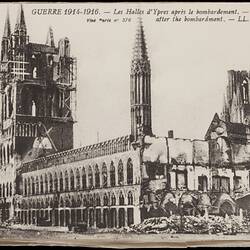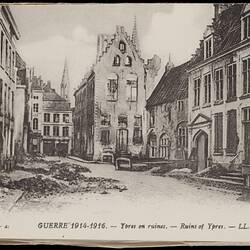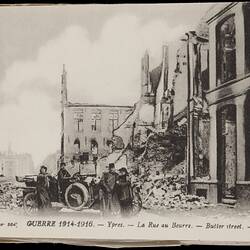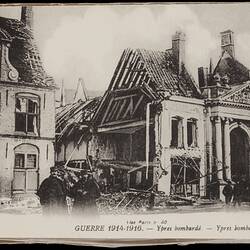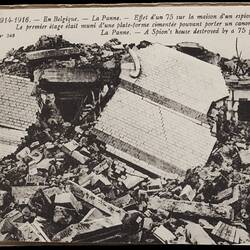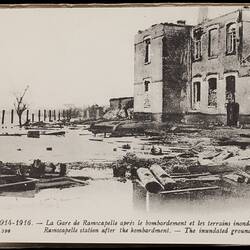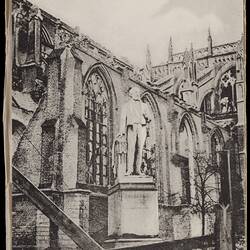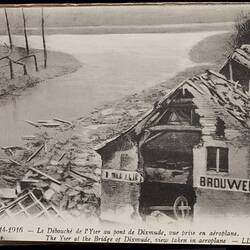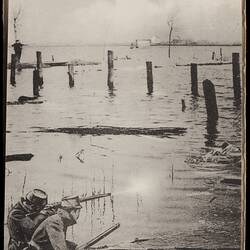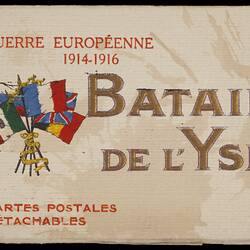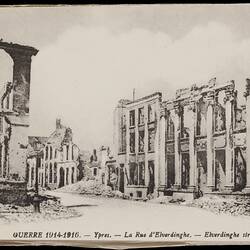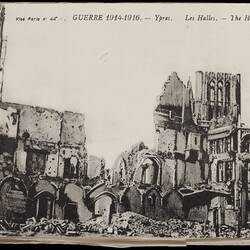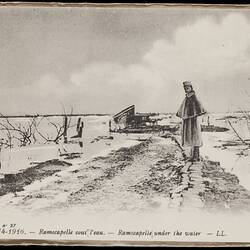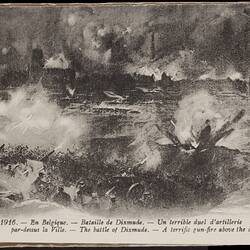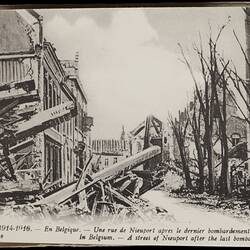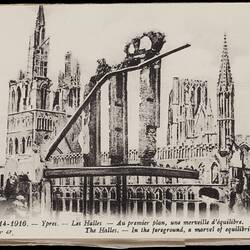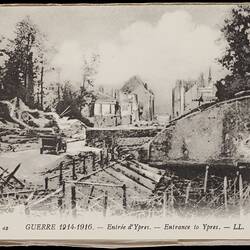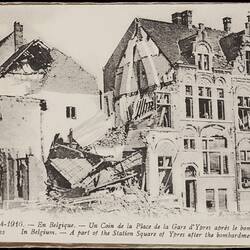Summary
Book of detachable postcards, Battle of L'yser, World War I.
This is a postcard book made of cardboard and firm paper, consisting of 20 black and white postcards, all of which are photographs depicting the physical impact of the Battle of Yser. The book has a cream coloured cover, which has red and gold lettering that states "Bataille De L'Yser" in large print, as well as depicting five countries flags in colour.
The booklet appears to have been produced as a souvenir circa 1916, well before the end of the First World War. It was presumably produced for sale to French and English soldiers who had survived the Battle of Ypres, and as such it provides a graphic reminder of the conditions at the end of the battles.
The Third Battle of Ypres took place in 1917, after this book was produced. The booklet seems to have been purchased by Sergeant John Lord of the 13th Field Ambulance, Australian Medical Corps, who returned to Australia after his service in France, as a souvenir.
Physical Description
This is a postcard book made of cardboard and firm paper, consisting of 20 black and white postcards, The book has a cream coloured cover, which has red and gold lettering, as well as depicting five countries flags in colour. The book opens with a blank page followed by the first postcard. The postcards are each separated by white tissue paper. The inside of the back cover contains blue text that appears to be advertising material, and each postcard has an identical back. Each postcard has a perforated edge where it could be removed from the book but it is fairly certain that no postcards have been removed. There is then a French description of each of the postcards located on the front at the top of each postcard, followed by an English translation.
Significance
A strategically important town in Belgium, Ypres was the scene of almost constant fighting throughout the First World War and was the focus for three highly significant Western Front battles. During the First Battle of Ypres (October to November 1914), German forces attempted to outflank the British Expeditionary Force but were thwarted, at great cost, in their "race to the sea". The Second Battle of Ypres (April 1915), is notable for the German's use of poisonous gas to support the attempted breakthrough by the German Fourth Army. Despite initial German successes the line was eventually stabilised by British and Canadian units. The Third Battle of Ypres (31 July to 10 November 1917) was the major British offensive in Flanders in 1917.
http://www.awm.gov.au/units/place_803.asp
It is most likely that these images were taken after the Second Battle of Ypres, and published during 1916.
The First Battle of Ypres was the last major battle of the first year (1914) of World War I.
This battle and the Battle of the Yser marked the end of the Race to the Sea where the Germans tried to reach the French Channel ports of Calais and Dunkerque, which were the main supply routes for the British Expeditionary Force. Major German advances would not resume until the Spring Offensive of 1918.
Outnumbered and exhausted, the British Expeditionary Force, under the command of General Sir John French, raced north from the mobile fighting of the first two months of the war to join two divisions of reinforcements recently landed in Belgium. They advanced east from St Omer, met and halted the German army at the Passchendaele Ridge to the east of the Belgian town of Ypres. Both sides dug in for trench warfare. The town of Ypres was rapidly demolished by artillery and air attack.
The Germans called the battle "The Massacre of the Innocents" (German "Kindermord"). Eight German units consisted of young volunteers, many of them enthusiastic students. Their offensive had been stopped by a British force, which although outnumbered was highly professional having learned many lessons from the Boer War. The BEF was supported for the first time by battalions from the Army of India and the British Territorials including new Canadian troops without whose support the Germans would surely have broken through. With tenacity and some good luck the ragged British line held on. The BEF was effectively destroyed at First Ypres but bought the British valuable time to reinforce the lines.
At the Second Battle of Ypres, the Germans used gas warfare for the first time.
More Information
-
Collection Names
-
Collecting Areas
-
Acquisition Information
Donation from J. Lord, 1986
-
Place & Date Depicted
Belgium, circa 1914-1916
Date of Battle of Yser (October 1914). -
Date Made
-
Inscriptions
On cover in red and gold: 'Bataille De L'Yser / Guerre Europèenne 1914-1916 / Cartes Postales Detachables / Sèrie 12 / LL' On each postcard there is an inscription at the top, and each inscription is opened with the words 'Guerre 1914-1916' and concluded with '- LL.' There is then a French description followed by an English one. The English descriptions are listed below in order of postcard: 1. The Halles after the bombardment 2. The Halles - in the foreground, a marvel of equilibrium 3. Ruins of Ypres 4. The Halles 5. The Cathedral Statue of Vandenpeerebom, miraculously saved 6. Ruins of Ypres 7. Entrance to Ypres 8. Elverdinghe street 9. Ypres - Butter street 10. Ypres - Butter street 11. Ypres bombarded 12. In Belgium - A part of the station square of Ypres after the bombardment 13. The battle of Dixmude - A terrific gun-fire above the city 14. The Yser at the Bridge of Dixmude, view taken in aeroplane 15. Ramscapelle under the water 16. Ramscapelle station after the bombardment - The inundated grounds 17. Ramscapelle under the waters - A German soldier attack of outposts is repulsed by Belgian soldiers
-
Classification
-
Category
-
Discipline
-
Type of item
-
Overall Dimensions
15 cm (Length), 8.6 cm (Width), 0.7 cm (Height)
-
Keywords
Belgian Communities, Belgian Immigration, Wars & Conflicts, World War I, 1914-1918, Making History - War Diaries and Correspondence

